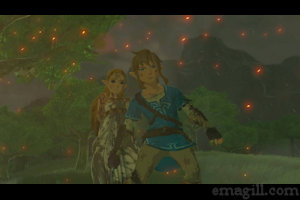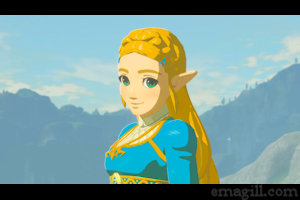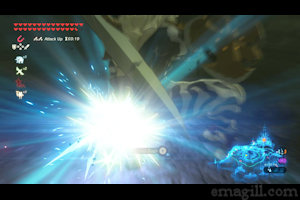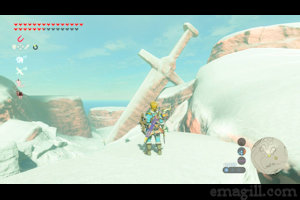The Legend of Zelda: Breath of the Wild
One of Nintendo's biggest franchises, The Legend of Zelda, has returned as a launch title for the new Nintendo Switch. Breath of the Wild has been a hotly anticipated game for years, acting as the primary hype machine for the Nintendo brand even before the Switch was announced. It promises to not only be a landmark experience, but also to break well-worn conventions many believe have weighed the series down since its high watermark, The Ocarina of Time. It is without a doubt one of the Big N's most ambitious projects, featuring a gargantuan open world, non-linear gameplay, and mechanics that have been revamped from the ground up. Does Breath of the Wild live up to the ludicrous hype and prove that Nintendo can still surprise gamers with AAA innovation, or is it an overrated title that proves that Nintendo may just be irrelevant in the modern era?
STORY
 | | You can never go wrong with an unambiguous good-versus-evil fantasy |
An amnesic Link awakens in a strange room to the voice of Princess Zelda, who informs him he's been asleep for a hundred years. He quickly learns that he is the last hope of a Hyrule decimated by an evil force called Calamity Ganon, a demonic spirit that slaughtered thousands when it hijacked the same ancient technology being used to keep it at bay for ten thousand years. Link must recover his memories, reclaim the ancient technology, find his lost sword, and face Calamity Ganon once more at the land's plagued heart, Hyrule Castle, where Princess Zelda has apparently been keeping the evil in a precarious stalemate.
Compared to plot-heavy recent entries in the franchise--including Twilight Princess and Skyward Sword--this tale is surprisingly straightforward. As the chronologically last entry in the franchise thus far, it relegates the previous games to a legendary status as ancient myths incredulously talked about by rumor mills and romantic ballads. While this narrative's connections to those ancient stories are there for fans willing to look for them, they aren't terribly important. All that Link needs to know is that there is this evil force called Ganon who wants to destroy Hyrule, and he and Princess Zelda are the only ones capable of defeating him. No one talks about the Triforce or any of the series' dark realms; there is no time travel; and there is no need to worry yourself with the convoluted timelines of The Hyrule Historia.
 | | She earns her titular place in the franchise |
This is not to say the streamlined story is any less compelling. If anything, it's easier to get invested in the characters when their motives are so clear and there are no hints at subterfuge or a coming dramatic twist. It can also be deep if you want to go looking for the breadcrumbs that tease you with answers to mysteries while filling in the gaps in Link's memories. For those who go out of their way to find all the lost memories, it becomes apparent that, while Link is unquestionably the protagonist, this story is more about Princess Zelda herself, a young woman with an unbearable weight of destiny on her shoulders and the unshakable feeling that she can never live up to it. I'd argue that this is the most vulnerable and pensive Zelda we've seen in the entire franchise--a far cry from the badass warrior of Ocarina of Time or the always-one-step-ahead tactician of Skyward Sword--but there is something poignant and relatable about her story, even as it is told almost entirely in flashback.
That said, the fairly simple story is reminiscent of the original The Legend of Zelda, a game where the whole story could fit on a couple of pages in an instruction booklet and really just boiled down to: a brave young warrior named Link takes down the evil Ganon and saves the captured Princess Zelda. You don't really need more than that, and keeping it simple is a bold decision for modern games that tend to rely more on twists and complex backstories than simple morality tales.
|
[STORY: 9.5 - While its refusal to even mention critical franchise elements like the Dark World and Triforce are a bit frustrating for hardcore fans, the emphasis on a simple, character-driven fairytale is refreshing for a series that has gotten a bit too confusing in the past.]
|
|
GAMEPLAY
 | | The combat can be pretty intense |
As with the story, the control scheme for Breath of the Wild is relatively simple. Gone are the waggle controls of Twilight Princess and Skyward Sword (though there are a handful of minor, few-and-far-between puzzles that ask you to use motion controls), replaced with a more conventional and intuitive system of dual thumb sticks and button presses. You can also run and jump at will, thanks to the returning stamina wheel and a less rigidly designed environment that emphasizes organic exploration over arbitrary limits and invisible walls. It's an incredibly liberating step, setting Zelda on equal footing with other blockbuster third-person RPGs.
There is also a much bigger focus on RPG elements, with a wealth of weapons and armor to collect, ingredients to farm, precious minerals to mine, insects to track down, upgrades to acquire, and food/potions to craft that will not only recover hearts and stamina, but also increase attack, defense, or environmental resistances, among much else. Enemies no longer drop health or rupees (there are one or two enemies that drop currency, but it's not enough to rely on in any way), instead leaving behind natural things like weapons, shields, arrows, and/or pieces of themselves. Rupees, then, are earned almost entirely through selling things in Link's inventory, and this system forces you to weigh the unknown future benefits of some quirky piece of Octorok tentacle over the need to buy another set of fire arrows. Indeed, in-game currency has never been handled as well in a Zelda game as it is here, with the balance absolutely spot-on between what you can easily make and what you need. Thankfully, you never have to worry about the size of Link's wallet, because he is unlikely to ever be overburdened with wealth.
In order to encourage the use of a bevy of weapons, shields, and bows, though, the game introduces a punishing durability system. For most melee weapons in the game--especially early on--Link will only be able to kill maybe three or four baddies before his weapon breaks. Link cannot repair a weakened weapon, nor can he design potions to improve a weapon's durability (a significant oversight, in my opinion). However--and I preface this with a minor and totally unnecessary spoiler alert--once Link gets his hands on the obligatory Master Sword, that game mechanic totally changes. While the Master Sword can never break, it does lose power and need to rest every so often, which gives Link a nice safety net that lets him preserve his most powerful weapons for when they are needed but still doesn't let him rely solely on one sword.
 | | Alas, you can't use this bad boy |
This is important, because Link's inventory space is quite limited. There is a way to upgrade his carrying capacity (which involves getting your hands on Korok seeds, a staggering 900 of which are scattered throughout Hyrule), but no matter how much space you set aside for weapons, it never feels like enough. If there is one RPG mechanic in the game that feels out of balance, this is it. On one hand, it is incredibly frustrating how little use Link can get out of any given weapon, but on the other hand, it's a little too easy to get more weapons. Shields and bows are a bit better handled, with upper level versions difficult to find and most of them taking far longer to break. In my entire playthrough, I think I broke maybe five shields, which compared with my tens of thousands of swords and hundreds of bows, is a tiny number.
Another new RPG element the game excels in is environment. There is dynamic weather, harsh climates, a day/night cycle, and many unique hazards depending on where Link is in the game world. This is where multiple suits of armor come in handy, as they are the only way to tackle the harshest of terrains. I'd complain about how rain greatly hampers Link's ability to climb, but that's a minor complaint when compared to the awesome ability to toss a metal weapon into a group of enemies and watch as they are struck down by an incredible lightning strike that leaves fire and death in its wake.
Link has multiple ways of getting around in this vast, open world. It is possible to tame wild horses, register them at one of many stables throughout the land, and then ride them everywhere but on the mountaintops, but more often than not, Link gets around by climbing to a high place and slowly paragliding great distances. It feels unbelievably empowering to drift over the beautifully rendered landscape, watching enemies look up in confusion as you pass them by and wild animals run out of the way as you creep closer and closer to the ground. If there's fire around, Link can even ride the updrafts to new heights, which is a great way to temporarily escape a brutal battle with a fire-breathing Lynel mere moments before he slams into you with his savage weaponry.
-e. magill 3/30/2017
|
|